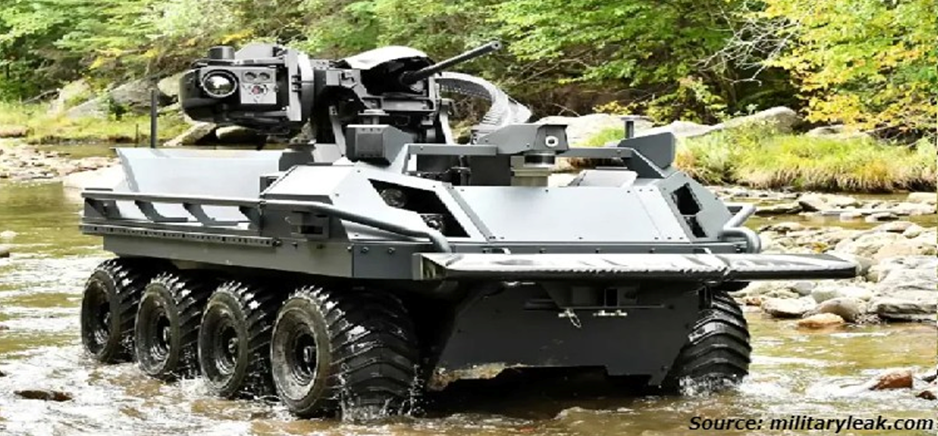
Drone Countermeasures Market by Type (Radar-Based Detection, Radio-Frequency (RF), Electro-Optical (EO), Infrared Radiation (IR), and Others), by Technology (Electronic System, Laser System, and Kinetic System) by Platform (Ground-based, Handheld, and UAV-based), by Mitigation Type (Destructive System and Non-destructive System), by Defence Type (Drone Detection & Disruption System and Drone Detection System), by End User (Military & Defence, Commercial, Government, and Others)- Global Opportunity Analysis and Industry Forecast 2024-2030
Market Definition
The Drone Countermeasures Market size was valued at USD 2.16 billion in 2023 and is predicted to reach USD 6.99 billion by 2030 with a CAGR of 18.5% from 2024-2030.
Anti-drone technology, also known as counter-drone or drone defence technology, refers to a broad range of systems designed to detect, track, and neutralize unmanned aerial vehicles (UAVs), commonly known as drones. These technologies can include electronic jamming, physical interception, software and even kinetic destruction. Electronic countermeasures involve the use of radar or other sensors to detect and track the drone, as well as countermeasures such as high-powered lasers or microwave-based systems to disrupt the drone’s communication systems or even disable it. Physical countermeasures include the deployment of physical barriers such as nets or jamming systems to disrupt the drone’s communication with its operator. Software-based countermeasures include the use of artificial intelligence and machine learning algorithms to detect and identify drones and respond with countermeasures such as jamming or disabling the drone. They can be used by military and civilian organizations to protect against potential threats posed by drones, such as espionage, smuggling, and terrorism.
Market Dynamics and Trends
The growing threat of terrorism and the use of advanced weapons, including drones, for terrorist activities across the globe, is driving the growth of the drone countermeasures market. According to the latest report published by the Global Terrorism Index, more than 8,000 people were killed in terrorist attacks in 2023, the highest level since 2017.
With such a rise in the terrorist threat landscape, there is an increasing need for effective countermeasures to mitigate the risks posed by drones in terrorist activities. Moreover, advancements in drone technologies, such as longer range, higher payload capacity, and autonomous functionality, are further driving the need for advanced drone countermeasures, boosting the growth of the market.
For instance, in March 2024, the Indian government initiated an anti-drone defense system at its borders due to the rising threat of drone attacks. As drones become more sophisticated and accessible, there is an increasing urgency for governments, military forces, and critical infrastructure facilities to deploy effective countermeasures to detect, track, and neutralize hostile drones before they pose a threat.
However, the high cost of development and deployment of drone countermeasures is the major factors restraining the growth of the drone countermeasures market. On the contrary, the introduction of artificial intelligence and machine learning in anti-drone technology is expected to create ample opportunities in the coming years.
These technologies enhance the ability of anti-drone systems to detect, track, and neutralize potential threats by enabling them to analyze vast amounts of data in real time, identify patterns indicative of malicious drone activity, and adapt their response strategies accordingly.
Market Segmentations and Scope of the Study
The drone countermeasures market share is segmented on the basis of type, technology, platform, mitigation type, defence type, end-user, and region. On the basis of type, the market is divided into radar-based detection, radio-frequency (RF), electro-optical (EO), infrared radiation (IR), and others. On the basis of technology, the market is classified into electronic system, laser system, and kinetic system. On the basis of platform, the market is segmented into ground-based, handheld, and UAV-based. On the basis of mitigation type, the market is divided into destructive system and non-destructive system. The destructive system is further classified into laser system, missile effectors, and electronic countermeasures. On the basis of defence type, the market is segmented into drone detection & disruption system and drone detection system. On the basis of end user, the market is classified into military & defence, commercial, government, and others. Regional breakdown and analysis of each of the aforesaid segments include regions comprising of North America, Europe, Asia-Pacific, and Rest of the World (RoW).
Geographical Analysis
North America holds the dominant share of the drone countermeasures market and is expected to continue its dominance during the forecast period. This is attributed to factors such as the increasing investment for counter-UAV solutions from the military and homeland security in countries such as the U.S. and Canada.
According to the Department of Defence, the government of the U.S. planned to invest USD 668 million in counter-unmanned aircraft system (C-UAS) research and development and USD 78 million in C-UAS procurement in 2023. Moreover, stringent government regulations and laws that require the use of anti-drone systems in certain areas such as airports, military bases, and other sensitive locations in the US and Canada is further driving the growth of the drone countermeasures market.
For instance, in March 2021, the US Federal Aviation Administration’s airport unmanned aircraft systems detection and mitigation research program planned to install anti-drone solutions in airports to minimize the risks posed by unmanned aircraft.
On the other hand, Asia Pacific is expected to show a steady rise in the development of the drone countermeasures market due to the increasing military and defence expenditure by major countries such as China, India, and South Korea. According to the World Bank, China's military expenditure reached USD 293.35 billion in 2021 as compared to 257.97 billion in 2020.
Moreover, the increasing adoption of anti-drone technology due to the rising terrorism and criminal activities in this region. For instance, March 2024, the Indian Army installed seven new indigenous integrated drone detection and interdiction systems (IDD&IS) developed by DRDO. These vehicle-based systems offer both "soft kills" of hostile drones through jamming and "hard kills" using lasers.
Competitive Landscape
Various market players operating in the drone countermeasures market include Advanced Radar Technologies S.A., Airbus Group SE, Blighter Surveillance Systems, Dedrone, DeTect Inc., Drone shield LLC, SRC Inc., Israel Aerospace Industries Ltd., Lit eye Systems Inc., Lockheed Martin Corporation, Prime Consulting and Technologies, Raytheon Company, RattanIndia Enterprises, Thales Group, The Boeing Company, and others. These market players are adopting various strategies such as product launches to remain dominant in the drone countermeasures market.
For instance, in September 2022, RattanIndia Enterprises launched its first anti-drone named ‘Defender’. The anti-drone used a soft-kill system to neutralise the rogue drone. The anti-drone needs to be at a distance of 30 m to effectively project the net and can move at a top speed of 26 m/s with a range of up to 20 km in a single flight.
Moreover, in March 2022, Raytheon Intelligence & Space launched its High Energy Laser Weapon System (HELWS) that can pair with the National Advanced Surface-to-Air Missile System (NASAMS) that can maximize their ability to identify, engage and destroy current and evolving enemy aircraft, unmanned aerial vehicles, and emerging cruise missile threats using electro-optical/infrared sensors.
Furthermore, in February 2022, SRC Inc. entered into a contract worth USD 8.79 million with the United Kingdom Ministry of Defence (MOD). The contract was aimed at providing in-service support services for the AN/TPQ-49 Lightweight Counter-Mortar Radar (LCMR).
Key Benefits
-
The report provides quantitative analysis and estimations of drone countermeasures market from 2024 to 2030, which assists in identifying the prevailing market opportunities.
-
The study comprises a deep dive analysis of the drone countermeasures market including the current and future trends to depict prevalent investment pockets in the market.
-
Information related to key drivers, restraints, and opportunities and their impact on the drone countermeasures market is provided in the report.
-
Competitive analysis of the players, along with their market share is provided in the report.
-
SWOT analysis and Porters Five Forces model is elaborated in the study.
-
Value chain analysis in the market study provides a clear picture of roles of stakeholders.
Key Market Segments
By Type
-
Radar-Based Detection
-
Radio-Frequency (RF)
-
Electro-Optical (EO)
-
Infrared Radiation (IR)
-
Others
By Technology
-
Electronic System
-
Laser System
-
Kinetic System
By Platform
-
Ground-based
-
Handheld
-
UAV-based
By Mitigation Type
-
Destructive System
-
Laser System
-
Missile Effectors
-
Electronic Countermeasures
-
-
Non-destructive System
By Defence Type
-
Drone Detection & Disruption System
-
Drone Detection System
By End User
-
Military & Defence
-
Commercial
-
Government
-
Others
By Region
-
North America
-
The U.S.
-
Canada
-
Mexico
-
-
Europe
-
The UK
-
Germany
-
France
-
Italy
-
Spain
-
Denmark
-
Netherlands
-
Finland
-
Sweden
-
Norway
-
Russia
-
Rest of Europe
-
-
Asia Pacific
-
China
-
Japan
-
India
-
South Korea
-
Australia
-
Indonesia
-
Singapore
-
Taiwan
-
Thailand
-
Rest of Asia Pacific
-
-
RoW
-
Latin America
-
Middle East
-
Africa
-
REPORT SCOPE AND SEGMENTATION:
|
Parameters |
Details |
|
Market Size in 2023 |
USD 2.16 billion |
|
Revenue Forecast in 2030 |
USD 6.99 billion |
|
Growth Rate |
CAGR of 18.5% from 2024 to 2030 |
|
Analysis Period |
2024–2030 |
|
Base Year Considered |
2023 |
|
Forecast Period |
2024–2030 |
|
Market Size Estimation |
Billion (USD) |
|
Growth Factors |
|
|
Countries Covered |
28 |
|
Companies Profiled |
15 |
|
Market Share |
Available for 10 companies |
|
Customization Scope |
Free customization (equivalent up to 80 working hours of analysts) after purchase. Addition or alteration to country, regional, and segment scope. |
|
Pricing and Purchase Options |
Avail customized purchase options to meet your exact research needs. |
KEY PLAYERS
-
Advanced Radar Technologies S.A.
-
Airbus Group SE
-
Blighter Surveillance Systems
-
Dedrone
-
DeTect Inc.
-
Drone shield LLC
-
SRC Inc.
-
Israel Aerospace Industries Ltd.
-
Lit eye Systems Inc.
-
Lockheed Martin Corporation
-
Prime Consulting and Technologies
-
Raytheon Company
-
RattanIndia Enterprises
-
Thales Group
-
The Boeing Company




 Speak to Our Analyst
Speak to Our Analyst


































